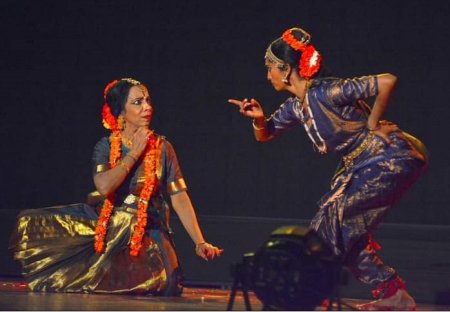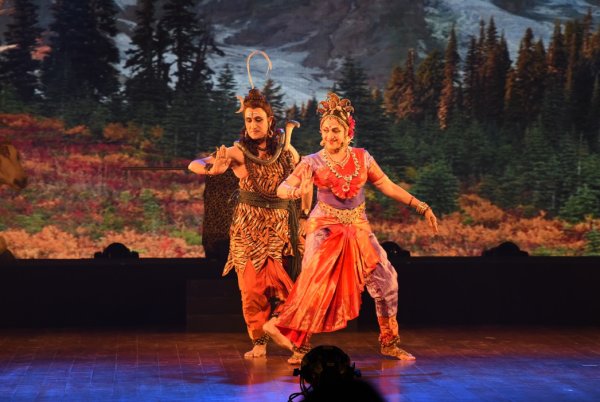
|   |

|   |
Aayana and Durga impress - Vijay Shanker e-mail: vijaydance@gmail.com December 27, 2022 "Six decades is a journey - Aayana, when a society transforms to a temple of fine arts and dance transforms to a visual prayer," was what Dr. Lata Surendra said as she reached out to the rasikas at the three day Nrithyotsavam organised by the Fine Arts Society, Chembur, that commenced on 18th November. Incidentally, the Society as well as the artiste, was celebrating six decades of a journey, endorsing dedication and commitment as more than just words. Replete with Ramarasayanam - and draped in the classical style of Bharatanatyam, it highlighted Mother Sita as moola prakriti (primordial energy) who is responsible for creation, sustenance and transformation (sristi, sthithi, laya) in this universe. The production endorsed the truth that in the presence of Parabrahma Rama, who is bliss incarnate, it is she alone, who creates this entire universe affecting effects. Inspired by Vyasa Rishi's Adhyatma Ramayana, the production extolled the path of bhakti and highlighted the Advaita philosophy. In fact, after listening to Valmiki's Ramayana, many great saints were inspired to write the Ramayana in their own language, style and based on their individual experience. According to their feelings and taste (rasas), they have re-written Ramayana without changing the basic story. Each could visualize Ramayana in a different manner. Therefore this was not their imagination, but it was the way in which Ramayana revealed itself to them that is narrated in their compositions. Both Valmiki and Adhyatma Ramayanas depict the story of Lord Rama through different angles. While Valmiki portrayed Lord Rama as an ideal person, Adhyatma Ramayana portrays Lord Rama as the incarnation of Parabrahma and mother Sita as moola prakriti.  Lata Surendra and disciple Conceived, choreographed, produced and presented by Lata Surendra with her disciples, Aayana was a new perspective on Ramayana - an epic journey of Rama that every Indian is aware of, the speciality of Vyasa Rishi's composition being that it combined Ramayana with Vedanta. The text which we should remember is a conversation between Shiva and Parvati. explaining the supreme essence of Rama (Srirama tattva) known as Srirama Hrudaya and had the power to grant moksha itself. From the holy text to stage is also a journey of paper to the stage, of word to light! In a skillful way, Lata Surendra related to Vyasa's 4242 verses with all the seven sections of Bala, Ayodhya, Aranya, Kishkinda, Sundara, Lanka and Uttara Kandam, through powerful scripting, musical score and using compositions highlighting the main text. The production opened with Sita addressing Hanuman. After his coronation, Rama requests Sita to accord 'jnanopadesha' which is initiation into divine knowledge to Hanuman who is the most eligible for it. It is the Mother who initiates knowledge and she says unto Hanuman: "Understand that I am the moola prakriti responsible for this creation, sustenance and absorption of this creation. In the presence of Parabrahma Rama, I create this entire universe with renewed dynamics that creates, transforms, sustains the epic journey as one that is 'inside out' to light up the light - Parabrahma that is Rama as Light: "Mām viddhi mūlaprakrtiṃ sarga sthithy anta kāriṇ Tasya sannidhi mātreṇa srjāmīdamatandritā" The eulogising of Rama as Parabrahma commenced with an interestingly choreographed piece that summed all that was to follow highlighting the truth of Rama as one who adhered to the sacredness of the word. The oft-performed piece of Sant Tulsidas's "Tumak chalat…." was given a new dimension as the consummate artiste that she is, she brought to life Kausalya's dismay at seeing the divine form of Rama... "How can I, a mother, embrace Agni?" she tells Rama... "Pray transform to a little child whom I can embrace and watch grow so as to rid all contaminants within me." All through one could see mother Kausalya's connection to the divinity around her as the dancing feet of little Rama, in all innocence indulged all, as a little child spreading bliss all around. She is overwhelmed as she sheds tears as he misses a step and falls when he was the one who in three strides subjugated the pride of Mahabali... and the one who answered the call of devotees in incarnations gone before! The audience clapped in appreciation spontaneously as each scene unfolded. It is said that all the world's a stage and a man plays many parts. Truly, Lata as Kausalya, Sita, Ravana, Kaikeyi, Bharata and Hanuman stole every heart with her command performance highlighting her experience of six decades. She was complemented by her senior disciples - Ananya Mohan Iyer as Rama, Lavanyakshi Uchhil as King Janaka and Lakshmana, Roopa Kotian as Maya Sita, Mega Mukesh Pillai as Maricha, Jatayu and other characters in the brilliantly choreographed production. The Sita K alyanam took everybody's breath away. Ananya as Ram incarnate complemented her Guru with poise and dignity expected of her. Bharata's meeting with his brother Ram choked her heart. The artistes and the soul merged as one in a spontaneous overflow of powerful feelings. The most evocative section was Hanuman meeting his Lord. Lata brought to life Veena Seshanna's composition with sensitivity. Bhakti at its peak was what we witnessed - mind, body and matter converging as surrender unto the lotus feet of the Lord. The ultimate truth of Hari and Hara as one through Ravana's eyes highlighted Rama as the 'One in all and All in One.' All through, one related to Sita as moola prakriti affecting every effect and leading the audience to the agni pareeksha that had her ultimately take the place of Maya Sita and proceeding to Ayodhya with Parabrahma Rama. The music laced by mellifluous vocalist N.N. Sivaprasad, high quality recording, skillful stage craft and lighting handled by Pednekar and sound by Nandlal Rele, made the finale of the day a memorable one that will linger in the minds of rasikas for a long time. As Lata Surendra says, "Dance remains a bridging metaphor for me, the aim being to express and move hearts to realization, if only to have cheeks glazed with salty rivulets as one dances the world's joys and sheds the world's tears..!" After thirty years, 'Durga' is still going strong Celebrated actress and Bharatanatyam exponent Hema Malini performed for a social cause on 4th November at the Nehru Centre auditorium in Mumbai. Hema Malini with her troupe of dancers and actors of Natyavihar Kalakendra presented the dance drama 'Durga.' Enacting the role of the goddess who fights against evil for peace and prosperity was the highlight of the dance drama choreographed by Bhushan Lakandri, presented with a beautiful musical score rendered by the veteran Ravindra Jain, enhanced with dramatic appeal, creating a lasting impression on the packed audience. After the performance, Hema Malini said, "I have been presenting Durga production for the last thirty years and am glad that I still continue to get amazing response from the audience, wherever I perform." The program was organised by Kalasadan as part of the Guru Mani Janma Shatabdi Kala Utsav 2022. The financial proceeds of the program was donated to Kalasadan Cultural Society towards the construction of Chintamani Ashram of Fine Arts in Titwala, a dream Gurukul project of the founder of Kalasadan, Guru Mani. Guru Nataraja Gopal, principal and son of Kalasadan Guru Mani said, "It is a dream project of Guruji to construct a Gurukul in which students from different parts of the country and abroad could reside and learn classical music and dance. It's a marathon task which is possible with personalities like Hema Malini, who has always supported and encouraged Guruji in all his pursuits. As we the students take forward his legacy, it is our duty to try to fulfill his dream which could not be materialized during his lifetime due to financial constraints. With generous contributions from the corporate sector and philanthropists it is possible to build the Chintamani Ashram of Fine Arts in Titwala. We need the financial support of everyone for this noble cause." Kalasadan Guru Mani was one of the foremost gurus of Bharatanatyan in Mumbai. He learnt from Guru Karunambal and Guru Govindarajan Pillai of Sri Rajarajeswari Bharata Natya Kala Mandir, one of the premier institutions of Bharatanatyam in Mumbai. Guru Mani established Kalasadan way back in 1951 and over the years has trained several students, many of whom have become professional dancers and teachers in different parts of the country and abroad. His eldest daughter Sharada, granddaughter Nandini Ganesan, Narayanaswamy, Sriram and several students all over the globe take the legacy forward. 'Durga' was presented by Hema Malini and group in the form of a humble offering to the divine mother and is an attempt to capture the religious fervour and devotion that invariably accompanies mother worship. The worship of the god as universal mother is based on the purest and noblest form of love. The Hindu scriptures, the Vedas and the puranas, make a reference to the worship as an integral part of sanatana dharma. The exalted rule of the goddess in creation and her boundless mercy, benevolence, love towards her children have inspired the great sages of the Vedic times to praise and sing her resplendent glory with devotion The sacred text that is most important and universally used in the worship of Durga is called Durga Mahatmyam or Durga Saptashati. The subject matter of this choreography is based on the stories from the Devi Mahatmyam and also from the common folklore of Sati, Parvati and Durga in that order. The dance drama commences with the joyous dance of Lord Shiva and Parvati; subsequently Parvati learns of the Daksha Yagna being conducted by her father. Shiva is not invited, hence does not attend but Parvati attends as she feels it is her duty to attend but is embarrassed as her father insults her and tells her that a recluse like Shiva should not be invited on such auspicious occasions. This further enrages her and she commits sati (self-immolation). Lord Shiva is enraged and destroys the Yagna. Later, Sati is reborn again and after severe penance marries Shiva. The last scene shows how the goddess is blessed by the gods with supernatural powers and finally destroys the demon Mahishasura to regain peace and prosperity.  MVN Murthy and Hema Malini MVN Murthy as Shiva is brilliant and dances the typical Kuchipudi movements with professional ease and proficiency, blending well with the elegant dance moves of Hema Malini. The male dancer who played Mahishasura was suitable. Appropriate choreography by Bhushan Lakandri and music by Ravindra Jain and great singers like Yesudas, Suresh Wadkar, Kavita Krishnamurthy, Hemalatha and Ravindra Jain made the entire presentation a musical delight. A fine combination of entertainment, artistic excellence and divinity. On behalf of Natyavihar Kalakendra, Hema Malini organizes the Jaya Smruti festival every year as a tribute to her dynamic mother whom she credits her success to. As part of the Guru Mani Janma Satabdi Utsav, Kalasadan has organised series of programs like Bharatanatyam margam by Nandini Ganesan, Andhra Natyam by the veteran Kala Krishna and disciples, mono act of the play 'Vivekananda' by Shekar Sen, Odissi by Shubhada Varadkar and disciples, Kuchipudi by disciples of Guru Smita Shastri, Kathak by Sunayana Hazarilal and disciples, Bharatanatyam by Chitra Visweswaran and Devi Mahatmyam and Ramayana by Kalasadan dancers.  Vijay Shankar is a Kuchipudi and Kathakali exponent, teacher, bilingual journalist, arts critic and actor. |